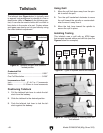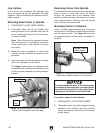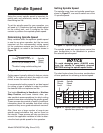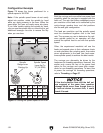
Model G0746/G0749 (Mfg. Since 3/13)
-45-
Note: The maximum quill travel is 4
3
⁄4", but
we do not recommend extending the quill
more than 2" or stability and accuracy will be
reduced.
Removing Center from Tailstock
Mounting Workpiece Between
Centers
Figure 58. Example photo of a workpiece
mounted between the centers.
3. Use the quill handwheel to feed the quill out
from the casting approximately 1”.
4. Insert the center into the tailstock quill.
5.
Seat the center firmly into the quill during
workpiece installation by rotating the quill
handwheel clockwise to apply pressure with
the center engaged in the center hole in the
workpiece.
Note: Only apply enough pressure with the
tailstock quill to securely mount the work-
piece between centers. Avoid overtightening
the center against the workpiece, or it may
become difficult to remove later, and it will
result in excessive friction and heat, which
may damage the workpiece and center.
To remove the center from the quill, hold onto it
with a gloved hand or shop rag, then rotate the
quill handwheel counterclockwise to draw the quill
back into the casting until the center releases.
If the center does not come loose by retracting the
quill, extend the quill to expose the slot shown in
the Figure below, then use a drift key to remove
the center.
1. DISCONNECT LATHE FROM POWER!
2.
Drill center holes in both ends of the work-
piece.
3.
Install a dead center in the spindle with a
lathe dog and a chuck, faceplate or drive
plate, then install a live center or carbide-
tipped dead center in the tailstock.
4.
Lubricate the workpiece center holes, then
mount it between the centers and hold it in
place with light pressure from the tailstock
center.
5.
Seat the center firmly into the quill by rotating
the quill handwheel clockwise to apply pres-
sure against the workpiece (see example in
Figure below).
Note: Only apply enough pressure to securely
mount the workpiece between centers. Avoid
over-tightening the center against the workpiece,
or it may become difficult to remove later. Also,
over-tightening will result in excessive friction and
heat, which may damage the workpiece or center.


















